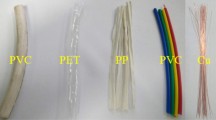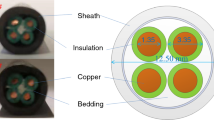Abstract
There is still a disagreement on how aging affects the risk of cable fire. In order to comprehensively assess the aging effects on cable fire risks, a series of cone calorimeter tests and flame spread experiments on accelerated thermal aging PVC cables were carried out with various thermal aging time. A large amount of fire characteristics was measured, including the ignition time (TTI), heat release rate, critical heat flux, fire performance index (FPI) and fire growth index (FGI) by cone calorimeter tests, as well as flame spread and dripping behaviors by flame spread experiments. Results showed that the values of TTI, FPI and the dripping frequency are increased with thermal aging time, but the maximum heat release rate, flame spread rate, FGI are decreased. It is evidenced that the thermal aging PVC cables have lower ignition risk, heat release risk, fire growth risk, but have a higher risk of dripping and igniting surrounding combustibles. This work may provide an in-depth understanding of fire risk of thermal aging cables.










Similar content being viewed by others
References
Ahrens M. Home structure fires. Quincy: National Fire Protection Association; 2016.
Bakhman NN, Aldabaev LI, Kondrikov BN, et al. Burning of polymeric coatings on copper wires and glass threads: I. Flame Propag Veloc Combust Flame. 1981;41:17–34.
Fernandez-Pello AC, Hasegawa HK, Staggs K, et al. A study of the fire performance of electrical cables. Fire Saf Sci. 1991;3:237–47.
Tewarson A, Khan M. Fire propagation behavior of electrical cables. Fire Saf Sci. 1989;2:791–800.
Konno Y, Hashimoto N, Fujita O. Downward flame spreading over electric wire under various oxygen concentrations. Proc Combust Inst. 2019;37(3):3817–24.
Konno Y, Hashimoto N, Fujita O. Role of wire core in extinction of opposed flame spread over thin electric wires. Combust Flame. 2020;220:7–15.
Huang XY, Nakamura Y, Williams FA. Ignition-to-spread transition of externally heated electrical wire. Proc Combust Inst. 2013;34:2505–12.
Hu LH, Zhang YS, Fujita O, et al. Flame spread over electric wire with high thermal conductivity metal core at different inclinations. Proc Combust Inst. 2015;35(3):2607–14.
Huang XY, Nakamura Y. A review of fundamental combustion phenomena in wire fires. Fire Technol. 2020;56:315–60.
Kobayashi Y, Nakaya S, Tsue M, et al. Flame spread over polyethylene-insulated copper and stainless-steel wires at high pressure. Fire Saf J. 2021;120:103062.
Lu Y, Huang XY, Hu LH, et al. The interaction between fuel inclination and horizontal wind: experimental study using thin wire. Proc Combust Inst. 2018;37(3):3809–16.
Ma YX, Zhang XL, Lu Y, et al. Effect of transverse flow on flame spread and extinction over polyethylene-insulated wires. Proc Combust Inst. 2020;38(3):4727–35.
Kikuchi M, Fujita O, Ito K, et al. Experimental study on flame spread over wire insulation in microgravity. Proc Combust Inst. 1998;27(2):2507–14.
Akira U, Mashahiro U, Tetsuya H, et al. Physical model analysis of flame spreading along an electrical wire in microgravity. Proc Combust Inst. 2002;29(3):2535–43.
Wang Z, Wang J. Experimental study on flame propagation over horizontal electrical wires under varying pressure. Int J Therm Sci. 2020;156:106492.
Kobayashi Y, Nakaya S, Tsue M, et al. Flame spread over polyethylene insulated copper and stainless-steel wires at high pressure. Fire Saf J. 2020;120:103062.
Kim M, Chung S, Fujita O. Effect of AC electric fields on flame spread over electrical wire. Proc Combust Inst. 2011;33(1):1145–51.
Zhang Y, Tang KX, Liu ZY, et al. Experimental study on thermal and fire behaviors of energized PE-insulated wires under overload currents. J Therm Anal Calorim. 2021;145:345–51.
Zhang Y, Zhang W, Tang KX, et al. Dripping behavior effects on flame propagation along electrical wires under high currents. Fire Saf J. 2021;123:103368.
Tang KX, Wu S, Zhang Y, et al. Analysis of heat transfer during flame spread over energized-wire under high currents. Int J Therm Sci. 2022;171(1):107191.
Grayson SJ, VanHees P, Green AM, et al. Assessing the fire performance of electric cables (FIPEC). Fire Mater. 2001;25(2):49–60.
McGrattan KB, Lock AJ, Marsh ND, Nyden MR. (2012) Cable heat release, ignition, and spread in tray installations during fire (CHRISTIFIRE): phase 1-horizontal trays. NUREG/CR-7010, U.S.NRC
Meinier R, Sonnier R, Zavaleta P, Suard S, Ferry L. Fire behavior of halogen-free flame retardant electrical cables with the cone calorimeter. J Hazard Mater. 2018;342:306–16.
Tang KX, Zhang Y, Jiang S, et al. A Comparative study on fire hazards of cables used in nuclear power plants based on small- and large-scale experiments. J Therm Anal Calorim. 2022;147:14659–71.
Omastova M, Podhradska S, Prokes J, Janigova I, Stejskal J. Thermal ageing of conducting polymeric composites. Polym Degrad Stab. 2003;82(2):251–6.
Tavares AC, Gulmine JV, Lepienski CM, Akcelrud L. The effect of accelerated aging on the surface mechanical properties of polyethylene. Polym Degrad Stab. 2003;81(2):367–73.
Wang Z, Xie T, Ning X, et al. Thermal degradation kinetics study of polyvinyl chloride (PVC) sheath for new and aged cables. Waste Manage. 2019;99:146–53.
Wang Z, Wei R, Ning X, et al. Thermal degradation properties of LDPE insulation for new and aged fine wires. J Therm Anal Calorim. 2019;137:461–71.
Xie QY, Zhang HP, Tong L. Experimental study on the fire protection properties of PVC sheath for old and new cables. J Hazard Mater. 2010;179(1):373–81.
Xie H, Zhang JQ, Liu YF, et al. Study on insulation failure time and failure temperature of the aged cables under external heating. Procedia Eng. 2018;211:1012–7.
Zhang BS, Zhang JQ, Li Q, et al. Effects of insulation material aging on ignition time and heat release rate of the flame retardant cables. Procedia Eng. 2018;211:972–8.
Kim MH, Seo HJ, Lee SK, et al. Influence of thermal aging on the combustion characteristics of cables in nuclear power plants. Energies. 2021;14(7):2003.
Lin JD, Cai L. Research on the thermal aging life prediction of XLPE cable. J Phys: Conf Ser. 2020;1570(1):012050.
Ren RH, Xu L, Li JX, et al. Investigation and life expectancy prediction on poly(ether-ether-ketone) cables for thermo-oxidative aging in containment dome of nuclear power plant. Polym Testing. 2021;103:107362.
Wypych G. Handbook of polymers. Amsterdam: Elsevier; 2016.
ISO 5660. International standard-fire tests-reaction to fire-rate of heat release from building products (ISO 5660). Geneva: International Organization for Standardization; 1993.
Wang Z, Wang J. An experimental study on the fire characteristics of new and aged building wires using a cone calorimeter. J Therm Anal Calorim. 2019;135:3115–22.
Quintiere JG. Fundamentals of fire phenomena. Hoboken: Wiley; 2006.
Zhang Y, Ma CY, Yang ML, et al. Can additive carbon nanotubes reduce the PMMA fire risk? Fire Saf J. 2023;136:103757.
Zhang Y, Yang ML, Yuan DC, et al. Fire hazards of PMMA-based composites combined with expandable graphite and multi-walled carbon nanotubes: a comprehensive study. Fire Saf J. 2023;135:103727.
Zhang Y, Huang XJ, Wang QS, et al. Experimental study on the characteristics of horizontal flame spread over XPS surface on plateau. J Hazard Mater. 2011;189:34–9.
Zhang Y, Sun JH, Huang XJ, et al. Heat transfer mechanisms in horizontal flame spread over wood and extruded polystyrene surfaces. Int J of Heat and Mass Transf. 2013;61:28–34.
Acknowledgements
This work was supported by the National Natural Science Foundation of China (Nos. 52074202, 52104211) and the Natural Science Foundation of Liaoning Province, China (Nos. 2022-KF-23-07).
Author information
Authors and Affiliations
Contributions
All authors contributed to the study conception and design. Material preparation, data collection and analysis were performed by [KT], [YZ] and [SW]. The first draft of the manuscript was written by [KT], and all authors commented on previous versions of the manuscript. All authors read and approved the final manuscript.
Corresponding author
Additional information
Publisher's Note
Springer Nature remains neutral with regard to jurisdictional claims in published maps and institutional affiliations.
Rights and permissions
Springer Nature or its licensor (e.g. a society or other partner) holds exclusive rights to this article under a publishing agreement with the author(s) or other rightsholder(s); author self-archiving of the accepted manuscript version of this article is solely governed by the terms of such publishing agreement and applicable law.
About this article
Cite this article
Tang, K., Wang, S., Fu, M. et al. Comprehensive assessment of the thermal aging effects on fire risks of PVC cable. J Therm Anal Calorim (2024). https://doi.org/10.1007/s10973-024-12959-2
Received:
Accepted:
Published:
DOI: https://doi.org/10.1007/s10973-024-12959-2




